Taking a Bite Out of the Big Apple
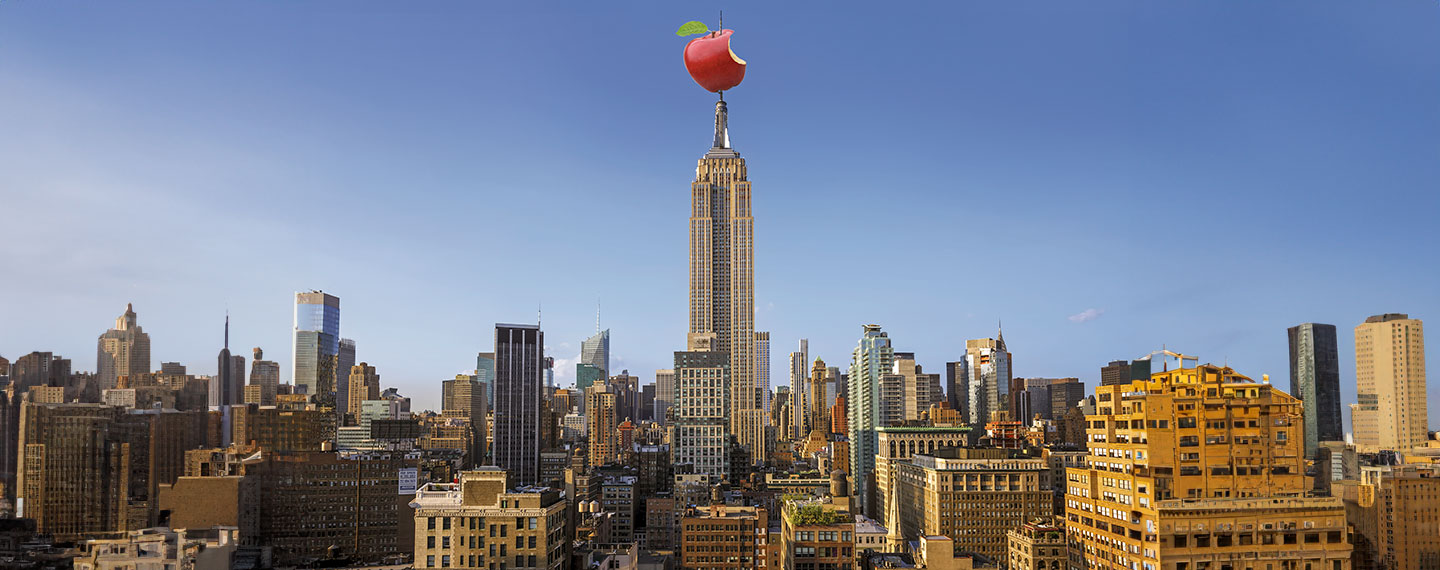
On the world's biggest stage, Ohio Wesleyan alumni are making a vital impact and living large in New York City.
"Empire City", "The City That Never Sleeps", "Gotham"
New York is the city of a thousand nicknames. Call it what you will, it's one of the world's most iconic destinations, drawing more than 60 million visitors in a typical year. Travelers come to bask in the glow of Times Square, see performances on Broadway, marvel at the museums, zoom to the top of the Empire State building for a birds'-eye view of the famous skyline, and seek out the best slices of pizza the world over.
As fun as their trips are, visitors often point to the skyscraper-high cost of housing, noisy traffic, and daunting crowds and ask, "How does anyone live here?" before making a swift exit. Yet, the city's 8.5 million residents recognize what the tourists miss: New York City is actually an amazing place to call home.
For proof, just ask the OWU alumni who've built their lives and careers in the Five Boroughs.
Here's a look at their stories and why they were drawn to New York City—and chose to stick around.
A Destination for the Dreamers
Going back home after graduation was a no-brainer for born-and-bred Brooklynite Paul Asencio '92, who identifies as a "New York guy to my core." His loved ones were all there, and he already knew that New York's dining, nightlife, and entertainment scenes were "second to none." But when major opportunities in the city's sports world opened up to him—starting with a job in sales with the New York Mets—he quickly realized New York was a place where fantasy could become reality.
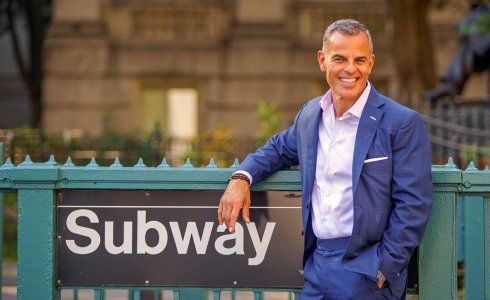
Last April, Paul Asencio took on the role of chief revenue officer at Williams Racing, leading the British Formula One team's commercial and marketing operations. Previously, he grew the sales departments at top sports brands, including the Ultimate Fighting Championship (UFC), Fanatics sports merchandise retailer, and the New York Mets. He started working in sales at New York Sports Clubs in 1993.
"I grew up a huge Mets fan and my dad was a huge Mets fan, so when I got that job, it was a dream come true," says Asencio. Over the next 17 years, he rose the ranks to become the Mets' senior vice president of corporate partnerships sales and services, never losing the thrill for having a hot dog at Citi Field (previously known as Shea Stadium) and sitting up close to the games.
Since then, his career has spanned many names in professional sports, including the licensed sports merchandise retailer Fanatics, Inc., the Ultimate Fighting Championship (UFC), and now Williams Racing, where he works as the British Formula One team's chief revenue officer.
"The biggest piece to my whole career is that I've always stayed around New York," says Asencio. "We have two teams in every single professional sport."
Even though he has spent the last 17 years commuting into the city from nearby Floral Park, where he relocated to get more space for his family, he and his wife often talk about moving back to Brooklyn—the place that first sparked his love of sports.
"On any given day in my childhood, my buddies and I would play pick-up basketball games in parks all around the city. It sticks with me to this day," he says.
Whereas Asencio always had a local's perspective on life in New York, Bhavna Murali '12 initially imagined it from afar. "Growing up in New Delhi, I always saw New York City in movies and TV shows. I also just loved the architecture and big buildings, the hustle and bustle, and the diversity I saw when I visited close friends here after college," says Murali.

In her role as senior consultant at the healthcare company Cerner Enviza, Bhavna Murali helps pharmaceutical and biotech companies with their clinical strategies for developing cancer-fighting drugs. "Helping efficacious drugs get to clinic quickly can have a significant impact on patients' lives, especially in oncology, where time is of the essence," she says. She completed her Ph.D. in cellular and molecular biology at Washington University in St. Louis in 2018.
So when she was offered the opportunity to put her education in cancer biology to use as senior consultant at the healthcare company Cerner Enviza, she jumped at the chance and made the move to New York in 2019.
"It was unique that my company asked me to move to New York, since a lot of pharmaceutical and biotech companies are in San Francisco," says Murali.
She finds deep meaning in her work helping to bring life-saving cancer drugs to the market. But Murali also appreciates what the city has brought her outside of her work life. The diversity of New York has allowed her to develop friendships with people from all walks of life, including through the Buddhist community Soka Gakkai International.
New York is one of the best places to be exposed to different people. It helps inspire you to take your limited vision of your career and life and open it up in a whole new way.
"New York is one of the best places to be exposed to different people. It helps inspire you to take your limited vision of your career and life and open it up in a whole new way," she says.
After four years, New York still fills her with awe.
"I'm a 10-minute walk away from Central Park, where everyone from all over the world comes on their vacation. Every time I go there, I get a 'pinch me' feeling," she says. "I never take any part of that for granted."
As fulfilling as life in New York can be, newcomers like Peter Reveles '14 say it takes guts to make the big move. He made his way to New York to work as a software engineer at Instagram after resigning from Facebook and traveling the world for 18 months. The journey took him to Spain, Morocco, Greece, Taiwan, Italy, and Mexico—to name just a few. It also prepared him to take on the Big Apple in the next stage of his career.
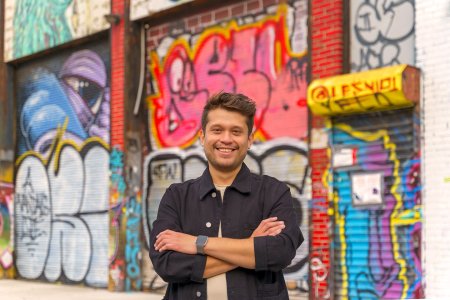
Peter Reveles' career as a software engineer has taken him to several social media start-ups, including Circle and Yo, eventually landing him a role working on Facebook's newsfeed and notification features in 2015. He left in 2018 to spend the next 18 months traveling the world and "to practice building software from 0-1." Reveles now lives in Brooklyn and works as a senior software engineer at Instagram. Reveles lives in Bushwick, a neighborhood in the northern section of Brooklyn that is famed for its street art.
"At any other point in my life, I would have been nervous about moving to New York. I remember thinking I could lose myself in a scary, big place, but after traveling and being in so many new places, I wasn't afraid," he explains.
The new home base actually felt smaller than Reveles had expected, largely thanks to the New York City Subway. It runs 24/7 and connects 472 stations across the five boroughs, serving 2.4 million riders per day. Combined with the buses, New York's public transit system is the largest in North America.
"It makes it so easy to get around and visit all the different neighborhoods. It makes it easy to get a sense of space and understanding of the geography of the city," says Reveles.
Being able to ride from one place to another has turned New York into a source of endless inspiration for Reveles and allows him to take advantage of city's opportunities to get creative, like taking a cinematography class at the School of Visual Arts.
"I think it would have been incredible to transition from the corporate life of a software engineer into the creative life of working in the film industry," he says. "But there are so many resources for whatever creative endeavor you want to do here, and that's one of the things I really enjoy about the city."
A Magnet for the Ambitious
New York's center as a powerhouse for so many industries makes it a magnet for the ambitious.
"I never intended to move to New York, but I came because it was the place to be if you wanted to be involved in the art world," says Debra Force '75.
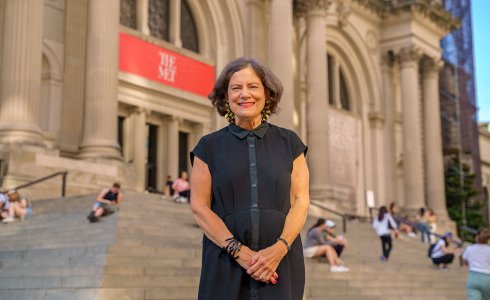
Millions of PBS viewers recognize Debra Force from her 25 years as an art appraiser on Antiques Roadshow. The Northeast Ohio native moved to New York to work in the American paintings department at Christie's, and today, she runs her namesake art gallery, which specializes in American art from the 18th-20th centuries and has sold works to many of the nation's leading museums. In the past year, she led the process to select an artist to paint the official portrait of Rock Jones, which was funded by donor gifts and will be unveiled next spring.
She first became enthralled by art auctions while working in Philadelphia as a corporate art collector for an insurance company. Naturally, when she heard about an opening in the American paintings department at Christie's auction house in New York, she applied and was offered the job in 1984.
"When I first moved here, the city's vibrance was very exciting. There was something new happening every day," she says. In her first decade in the city, she organized more than 40 American art auctions at Christie's and provided appraisals for museums and collectors.
In 1999, she made her own mark on New York's art world, forming Debra Force Fine Art on the Upper East Side. Through the gallery, she has sold works to more than 70 museums in New York and beyond, including the Metropolitan Museum of Art, the Whitney Museum of American Art, and the New-York Historical Society. She says it's been one of the most rewarding parts of her work. "Museums are generally looking for the best or rare works. If they feel something I have in inventory meets those requirements, it's gratifying to know that my opinion of this work of art is justified. It's also wonderful to be able to share these works of art with the public at a much greater scale than any gallery could provide," she says.
New York's not only the center of the art world—it's also the "media capital of the world," says Tom Goodman '76. After learning how to pitch and write stories as a reporter at the Delaware Gazette, he moved to New York and transitioned into the other side of media—public relations.
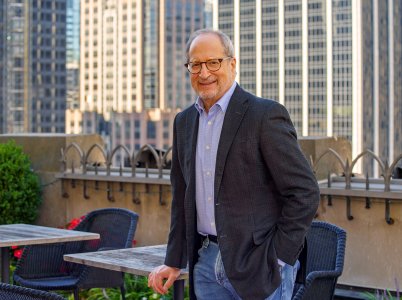
Tom Goodman took the skills he learned from legendary journalism professor Verne Edwards and as a reporter with the Delaware Gazette and applied them to a career in public relations and communications. After managing news information at ABC News, he founded Goodman Media International in 1996, and his firm has counted British Airways, Bloomberg, MSNBC, and Neiman Marcus among its many clients. He regularly employs summer interns from OWU and hosts visiting students from the Economic Management Fellows program.
He started at the communications department at J. Walter Thompson advertising company, working on national media relations campaigns for clients such as the Eastman Kodak Company, before spending the next 15 years working in PR for network TV at ABC and CBS. Then, New York presented Goodman with an opportunity to do something he never planned: Start his own PR company. It all began with a meeting with British Airways after a referral from a journalist friend.
"I went out to their headquarters near LaGuardia Airport with nothing—no briefcase, no company, no business cards," says Goodman. The British Airways team wanted help publicizing an extreme promotional stunt they were planning that involved crowning a Times Square building with a half-size model of a Concorde airliner, and wanted to know whether he could take on the project. He agreed, and that's when Goodman Media International took off.
The company has since taken on campaigns for a number of notable clients, including Bloomberg, Animal Planet, HBO, National Geographic, and Scholastic, and Goodman has grown his team to about 20 to help with the work.
"There's an energy and excitement in New York. It's a good place for type A personalities. The people who want to come and work here make it easier to hire," he says.
Expanding his staff has been a rewarding experience for Goodman. He loves helping budding PR professionals, including interns from OWU, learn the ropes and get their footing in the city.
"Helping younger people get started in their careers gives me more pleasure than the work itself," he notes.
One of Goodman's favorite journalists to work with, Tom Jolly '77, who he'd known since his college days, made his foray into New York media as assistant sports editor at The New York Times in 1993. Jolly already had around 15 years of reporting experience under his belt after working at newspapers in Ohio, Maryland, and Pennsylvania.
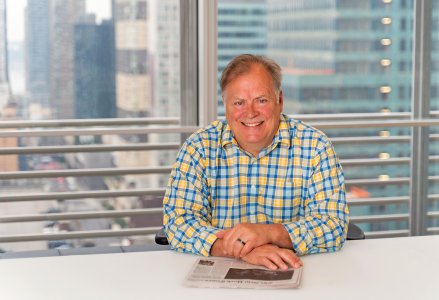
After working at newspapers in Ohio, Maryland, and Pennsylvania for 15 years, Tom Jolly joined The New York Times as assistant sports editor in 1993. Since then, he has served as the paper's senior news editor and sports editor, helping earn the paper a prestigious George W. Polk Award in 2009. Jolly is now the associate masthead editor at the Times, managing a team of 80 staffers to design and edit the daily newspaper.
Working at The New York Times allowed him to continue advancing in his journalism career while newsrooms elsewhere struggled to stay afloat. In 2003, he began his eight-year tenure as the paper's sports editor, during which time his section's coverage on the hidden dangers of concussions earned a George W. Polk award. He now oversees production of the newspaper as its associate masthead editor.
"It's been a great experience to be at the Times during a period when it's been very difficult for the business in general," he says. "We've been fortunate enough to have a good business plan, maintain the standards that we've always held to, and remain an important part of the world of journalism."
While Jolly admits that it's very difficult to work in journalism everywhere these days, he says New York City is still a worthwhile place for new reporters to try to get their foot in the door.
"New York is headquarters for so many different journalism operations, from all the mainstream organizations to all the TV networks. There are also a tremendous number of digital sites, like Vice, the Daily Beast, and BuzzFeed," he says.
Plus, the city sights lend themselves to all kinds of storytelling, including photography—Jolly's avocation. He enjoys taking photos around the city and browsing B&H, a 70,000-squarefoot camera and gear store that's been a Manhattan mainstay for 50 years.
A Home for Public Service
New York City is one of the most densely populated places in the country. Living in such close quarters can be overwhelming, but it also fosters a strong sense of community and a desire to make the city—and the world at large—a better place. That's what drove native Manhattanite Matthew Levy '01 toward a career in public service.
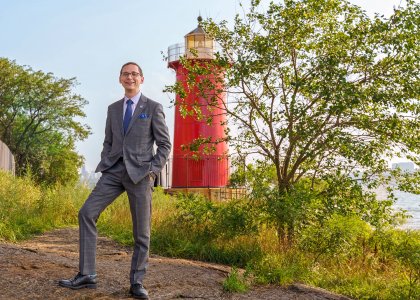
Born and raised in Manhattan, Matthew Levy's career has spanned from practicing law to pushing progressive policies through the New York state legislature. "I'm a public servant at heart, and I always will be," says Levy, who in September became a senior court attorney for the New York County Supreme Court. Previously, he was counsel and legislative director for the office of New York State Senator Robert Jackson. "The Little Red Lighthouse in Washington Heights is one of my favorite places in my neighborhood. The lighthouse is a hidden gem in NYC."
"Fighting for the interest of our communities to make New York City safe and habitable for everybody is one reason I came back to my home," says Levy.
Through his job as counsel and legislative director for the office of New York State Senator Robert Jackson, Levy works to advance progressive bills focused on topics like expanding family leave eligibility and ending qualified immunity through the state legislature. He also distributes discretionary funds to community-based organizations to help those in need.
Fighting for the interest of our communities to make New York City safe and habitable for everybody is one reason I came back to my home.
It's a demanding job that requires Levy to spend significant time in the state capital, Albany. But when the legislature is out of session and he's back home in his beloved Manhattan neighborhood of Washington Heights, he continues to find other ways to make a difference, including participating in New York County's Democratic Committee, serving on his community board, and attending rallies and protests.
"New York City was not the place to be when I was growing up here in the '80s and early '90s. It's radically different from what it once was, and that inspires me to help continue making the city better for everybody," he says.
Gargi Pal Chaudhuri '01 also carves time out of her hectic schedule to give back. After moving to New York in 2001 to work on the government bond trading desk as vice president at Merrill Lynch, she found that jogging through Central Park proved to be a great way to recharge. Logging those miles became an essential part of her life, so she started to look for ways to use it as a force for the greater good, as well.
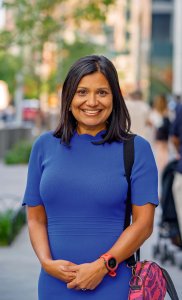
With more than 20 years of experience in the financial services industry, Gargi Pal Chaudhuri may soon be more widely known for a series of short videos on YouTube called "Market Mythbusting with Gargi Chaudhuri," where she offers market tips and analysis. She began her career at Merrill Lynch before running the U.S. inflation trading desk as vice president at Jeffries & Co. She has spent the past 13 years at the investment company BlackRock, where she is head of iShares investment strategy Americas. Chaudhuri's office is in 50 Hudson Yards, one of New York's largest commercial towers.
"Every year that I run the New York City Marathon, I raise money for Shoe4Africa, an amazing charity that has built a hospital in Kenya entirely for children," says Chaudhuri, who is now head of iShares investment strategy Americas at BlackRock. "Running outside of work is a pretty high priority, so I try to find ways I can tie running to giving back. I've run about 25 marathons in total."
Running in New York—whether for noble causes or just to blow off steam—offers some personal rewards, as well. "Run a loop around the Central Park Reservoir at sunrise," says Chaudhuri. "It's absolutely stunning."
While some New Yorkers work to affect positive change in their spare time, others like Sophia Bogues '92 have made entire careers of it. She grew up in Queens after immigrating to New York from Jamaica as a child and returned a year after graduating from OWU. Unsure of exactly what she wanted to do at first, she started working at community-based organizations like Boys Harbor, which provides education and character development for children in Harlem and the Bronx, and INROADS, a nonprofit dedicated to creating career pathways for ethnically diverse high school and college students. She quickly realized how rewarding it was to help prepare young students for their futures.
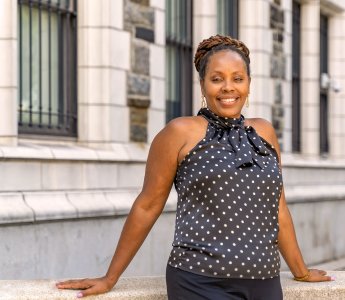
"Being in New York City has allowed me to touch so many students' lives," says Sophia Bogues. She has spent the last 13 years as director of the City College of New York's early college program, which introduces middle and high school students to college life and provides ongoing academic support. Prior to that, she recruited diverse students for internships at Fortune 500 companies through the nonprofit organization INROADS.
She now serves as director of the early college program at the City College of New York, a public research university whose campus in Hamilton Heights is filled with Collegiate Gothic buildings that are lit beautifully after dark. Through the program, which promotes college awareness to students as early as 8th grade and helps them earn college credits, Bogues estimates that more than 1,000 students she's worked with have gone on to graduate from college.
"I've touched so many students' lives who've gone on to be these wonderful adults and contributing members of our society," she says. "Being in the city has provided me the opportunity to do that. It's been a wonderful experience."
If You Can Make It There…
From helping the next generation achieve academic success to launching thriving businesses, OWU alumni have found their own individual ways to make an impact in New York. But the one thing they all share is the foundation that Ohio Wesleyan provided them to succeed in the city.
For some, like Chaudhuri, OWU opened up the door to New York City before they even received their degree.
"The summer between my junior and senior years, I interned at a financial firm in New York and they made me a full-time offer," she says. "I came back to the city after graduating and I've been here ever since."
This direct connection between OWU and New York continues to grow, as about 25 students a year have OWU Connection experiences—such as internships, research, and meetings with alumni—in New York City.
In a city as big as New York, success is often dependent on who you know. OWU alumni, like Goodman, credit the strong network of friends and colleagues they developed at OWU for key milestones in their careers. He received his first job offer in public relations from a person whose wife went to OWU.
"It was fortuitous," he says. And when he launched his company, he looked to someone he played with on OWU's lacrosse team for help securing office space—essential assistance, given how prohibitively expensive commercial real estate can be in New York.
"He literally took me in, gave me nominal rent, and let me use a small conference room," Goodman explains.
OWU's liberal arts curriculum gave some alumni, like Force, an edge in carving out a niche in their industry. Even though she was primarily studying history, politics, and government, she also took an American folk art course that provided knowledge she'd use for the rest of her career.
"I'm a poster child for a liberal arts education," she says. "My experience at OWU helped get me to where I am—it's been invaluable to me throughout my life."
Joni Sweet is a freelance writer and editor living in New York City and is the author of 48 Hours: New York.
